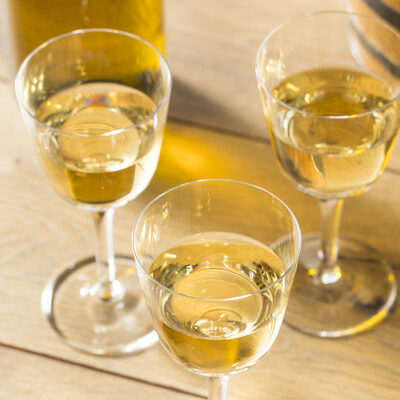
Sherry
What is Sherry?
Sherry is a type of fortified wine made from white grapes in Andalucia, Spain. This wine is typically produced in the “Sherry Triangle” in this southwest region of Spain.
- The grapes used to make this wine are Palomino, Pedro Ximenez, and Muscat.
- The flavor of this wine can range from sweet to oxidized to dry, depending on the type.
While the market has decreased in recent years, fortified wine is expected to garner a revenue of $14 billion by 2024.
The most popular brands sold in the US, according to Statista are:
- Tio Pepe
- La Guita
- La Gitana
- La Ina
- Fina Quinta
- CB Alvear
- Domecq
- Argüeso
- Dry Sack
Origin of sherry
Fermented drinks made from fruit, rice, and honey date back to 7,000 BC – 6,500 BC in ancient China. In the oldest known winery, located in Armenia, ancient winemaking vessels were discovered from 4,100 BC. Phoenecian traders later brought wine and grapevines to the Mediterranean, where they flourished. The Romans are often credited with turning wine into an industry to produce higher quality beverages between 3,000 BC – 2,000 BC.
The first mention of sherry in history was in 100 BC by a Greek geographer named Strabo. Strabo wrote that the first vines were brought to Greece by Phoenecian traders in 1100 BC. In 711 AD, the Iberian peninsula was occupied by the Moors. Although they prohibited the sale of alcohol, the area of Sherish (Jerez) continued to produce alcohol. When the Spanish king reclaimed the area in 1264, it became protected for its winemaking and the history that goes along with it.
Function
As is true with many wines, these alcoholic beverages crafted from fermented grapes can provide a world of flavor in the kitchen. When cooking, you can use this in sauces, glazes, and gravies. These work just as well for vegetables as they do meats. This fortified wine is also a crucial ingredient in creamy soups. Of course, you can always drink sherry as a sweet aperitif or an after-dinner wine.
Nutrition
A 3.5 fl oz glass can contain:

Studies have shown that this dessert wine shares some of the heart-health benefits associated with red wine. This can decrease cholesterol levels and increase good cholesterol in the body. However, alcoholic drinks should always be consumed responsibly and in moderation to avoid weight gain, liver problems, and other health issues.
Commercial production
The commercial production begins with making the base wine from crushed grapes. After, the wine base is fortified with additional alcohol and then placed in wooden barrels. These barrels are stored in a wine bodega to be aged. Each year, the wine will pass from one barrel to another as it ages, giving it more flavor and allowing the wine to age biologically. Finally, the sherry is bottled, corked, labeled, and stored until ready to be sold.
Uses
Sherry pairs well with a variety of food from crunchy almonds to salty ham. However, to enjoy this fortified wine to the fullest you should ensure that it’s stored correctly. It should be stored upright and kept in a cool, dark place. Dessert wines should always be kept away from heat to keep them from going bad quickly. Also, wines must be stored away from light and shouldn’t undergo any big changes in temperature, as this can affect their quality.
The most common varieties of this wine include:
- Fino
- Amontillado
- Oloroso
- Rava
- Palo Cortado
- Pedro Ximenez
- Moscatel
- Manzanilla
Sherry recipes
This beverage can be enjoyed alone or used to add flavor to many dishes. Here are some popular recipes:
- Creamy Lobster Bisque
- Mushroom Ravioli with Sherried Chicken
- French Onion Soup
- Sherry Potatoes
- Pork Chops in Sherry Mushroom Gravy
FDA Regulation
The Food & Drug Administration regulates the bottling, packaging, and labeling of wine. However, it is the Alcohol, Tobacco Tax, and Trade Bureau that is in charge of inspecting and enforcing these regulations. The TTB defines sherry as a “type of grape dessert wine having the taste, aroma, and characteristics generally attributed to sherry.” This wine must have an alcohol percentage of more than 17% but not exceeding 24%. Light sherry, however, must have an alcohol percentage of more than 14% but not exceeding 17%. Furthermore, this wine must be produced in Spain unless grandfathered.
References
“Wine: Beverage.” Truefoodfact.com, True Food Fact, 22 June 2020, truefoodfact.com/beverage/wine/.
“History of Sherry.” Sherry.wine, Sherry Wines Vinos De Jerez, 9 Aug. 2018, www.sherry.wine/copa-jerez/history-of-sherry.
“The Beverage Alcohol Manual.” Ttb.gov, Department of the Treasury Alcohol, Tobacco Tax & Trade Bureau, 1 Aug. 2018, www.ttb.gov/images/pdfs/wine_bam/complete-wine-beverage-alcohol-manual.pdf.
